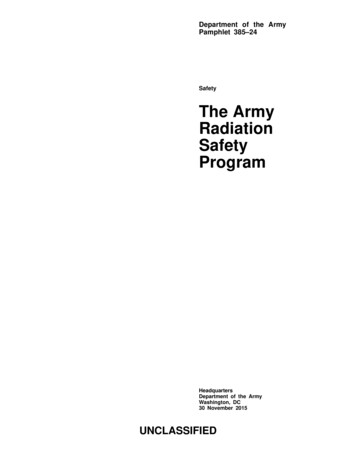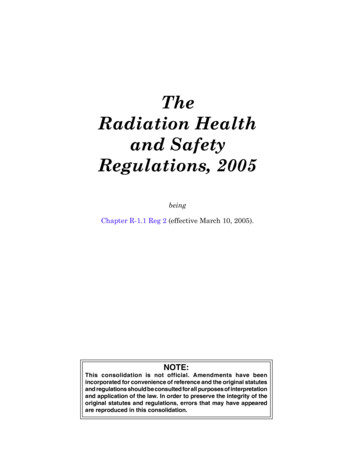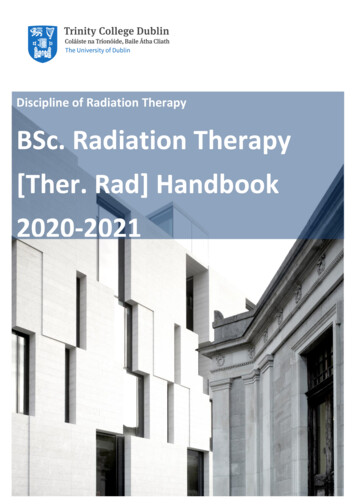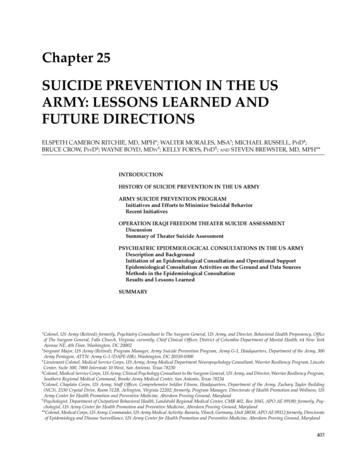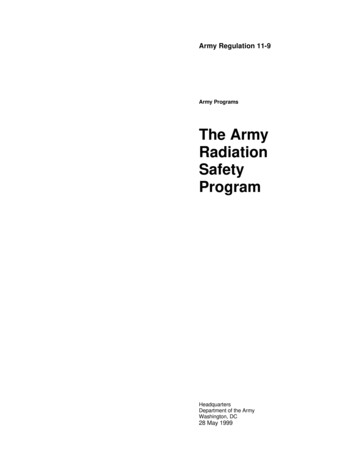
Transcription
Army Regulation 11-9Army ProgramsThe ArmyRadiationSafetyProgramHeadquartersDepartment of the ArmyWashington, DC28 May 1999
This page left blank intentionally.
HeadquartersDepartment of the ArmyWashington, DC28 May 1999*Army Regulation 11-9Effective 29 June 1999Army ProgramsThe Army Radiation Safety ProgramHistory. This is a new regulation.Summary. This regulation prescribes Armyradiation safety policy. It is a consolidation ofseveral regulations that partially covered thispolicy. It implements DODI 6055.8 and DODI6055.11. It includes Army policy for the use,licensing, disposal, transportation, dosimetry,accident reporting, safety design, and inventorycontrol of and radiation exposure standards forionizing and nonionizing radiation sources.This regulation updates policy to be consistentwith current Federal radiation safety regulations; simplifies Army radiation authorization,Army radiation permit, and Nuclear RegulatoryCommission license application procedures;requires Army radiation authorizations for theuse of machine-produced ionizing radiation;and strengthens MACOM and installation radiation safety authority.Applicability. This regulation applies to theActive Army, the Army National Guard of theUnited States, the Army Reserve, and Armycontractors. This regulation does not apply tonuclear weapons (AR 50-5).Proponent and exception authority. The proponent of this Army regulation is the Director ofthe Army Staff (DAS). The DAS has the authority to approve exceptions to this regulation thatare consistent with controlling law and regulation. The DAS may delegate this authority, inwriting, to a division chief within the proponentagency in the grade of colonel or civilianequivalent.Army management control process. Thisregulation contains management control provisions and identifies key management controlsthat must be evaluated.Supplementation. Supplementation of thisregulation is prohibited without prior approvalfrom HQDA (DACS-SF), WASH DC 203100200.Suggested improvements. Users are invitedto send comments and suggested improvements on DA Form 2028 (RecommendedChanges to Publications and Blank Forms) directly to HQDA (DACS-SF), WASH DC 203100200.Distribution. This publication is available inelectronic media only and is intended for command level C for Active Army and D for ArmyNational Guard of the United States.*This regulation supersedes AR 40-14, 30 June 1995; AR 40-46, 15 November 1974; AR 385-9,1 April 1982; and AR 385-11, dated 1 May 1980AR 11-9 l 28 May 19991
Table of ContentsChapter 1. 5Introduction . 51-1.1-2.1-3.1-4.1-5.1-6.1-7.1-8.1-9.Purpose . 5References. 5Explanation of terms. 5Responsibilities . 5Army Radiation Safety Council. 9Installation Radiation Safety Committee . 9Radiation Safety Committee. 10General. 10Deviations . 10Chapter 2. 11Ionizing Radiation Sources. 112-1.2-2.2-3.2-4.2-5.2-6.2-7.2-8.General. 11Nuclear Regulatory Commission licenses. 11Army radiation authorizations. 11Army radiation permits. 12Decommissioning records. 13Transfer and transport . 13Radioactive waste disposition . 14Survey instruments. 14Chapter 3. 17Lasers . 173-1.3-2.General. 17Military-exempt lasers. 17Chapter 4. 17Radiofrequency electromagnetic radiation. 174-1.4-2.General. 17Measurement and evaluation of RF fields. 18Chapter 5. 18Radiation safety standards, dosimetry, and recordkeeping . 185-1.5-2.5-3.5-4.General. 18Ionizing radiation . 18Radioactive contamination. 20Nonionizing radiation . 20Chapter 6. 23Special reporting requirements. 236-1.6-2.General. 23Ionizing radiation . 23Appendix A. 24Publications. 24Section I Required Publications . 24Section II Related Publications . 26Section III Prescribed Forms . 28Section IV Referenced Forms. 28AR 11-9 l 28 May 19992
Appendix B .29Sample application for Army Radiation Authorization (DA Form 3337) .29Appendix C .31Management Control Evaluation Checklist.31C-1.C-2.C-3.C-4.C-5.C-6.Function . 31Purpose . 31Instructions. 31Test questions . 31Supersession . 31Comments. 31Glossary.32Section I Abbreviations. 32Section II Terms. 36Index .44AR 11-9 l 28 May 19993
Summary of ChangeAR 11-9Army ProgramsThe Army Radiation Safety ProgramThis publication— Establishes radiation safety policies and procedures for all ionizing and nonionizing radiation sources used by Army personnel or on Army installations (locatedthroughout).Establishes the position of Army Radiation Safety Officer (para 1-4).Establishes the Army Radiation Safety Council (para 1-5).Provides personnel radiation exposure standards (table 5-1).Provides radioactive contamination guidelines and radioactive waste disposal instructions (para 5-3).Provides radiation accident and incident reporting policies (chap 6).Provides instructions for applying for Nuclear Regulatory Commission licenses,Army radiation authorizations, and Army radiation permits (chap 2).Integrates risk management into the Army radiation safety program (chap 1).AR 11-9 l 28 May 19994
Chapter 1Introduction1-1. PurposeThis regulation establishes policies and procedures for the use of, licensing, disposal, transportation,safety design, and inventory control of ionizing and nonionizing radiation sources. It also providesradiation exposure standards and dosimetry and accident reporting instructions. Its objective is toassure safe use of radiation sources and compliance with all applicable Federal and DOD rules andregulations.1-2. ReferencesRequired and related publications are listed in appendix A.1-3. Explanation of termsAbbreviations and special terms used in this regulation are explained in the glossary.1-4. Responsibilitiesa. The Assistant Secretary of the Army (Installations and Environment) (ASA(I&E)) establishesoverall Army environment, safety, and occupational health policy and maintains general oversight of and serves as advocate for the Army Radiation Safety Program.b. The Assistant Secretary of the Army (Manpower and Reserve Affairs) establishes overall Armyhealth and preventive medicine policy and maintains oversight of medical and health aspectsof the Army Radiation Safety Program.c. The Director of Army Safety (DASAF), Office of the Chief of Staff, Army, will(1) Provide Army Staff oversight of the Army Radiation Safety Program.(2) Administer, direct, and integrate Army Force Protection risk management (AR 385-10).(3) Chair the Army Radiation Safety Council (ARSC).(4) In coordination with the ASA (I&E), designate, in writing, a qualified nuclear medical science officer (SSI 72A67C) colonel to serve as Army Radiation Safety Officer (ArmyRSO).d. The Commanding General, Army Materiel Command (AMC) will—(1) Control NRC (Nuclear Regulatory Commission) licenses and Army radiation authorizations for Army radioactive commodities.(2) Provide ionizing radiation dosimetry services (at the Army Ionizing Radiation DosimetryCenter (AIRDC)) that meet the requirements of 10 CFR 20.1501(c). The Chief, AIRDC,will—(a) Publish instructions for starting, maintaining, and ending personnel dosimetryservices (SB 11-206).(b) Maintain the Army's Central Dosimetry Records Repository (CDRR). The CDRRwill archive comprehensive dosimetry records for all Army personnel and for otherpersonnel who use Army dosimetry services. Records will meet the requirementsof 10 CFR 20.2106 and 20.2110. Records will include results of bioassays, administrative dose assignments (including copies of documents that make the assignments), and supplementary occupational dose equivalent information (for example, dosimetry information resulting from off-duty employment, “moonlighting”)that any radiation safety officer (RSO) reports. In particular, the AIRDC will meetthe requirements of 10 CFR 20.2106(f) for long-term retention of these records.(c) Provide quarterly personnel dosimetry reports (automated dosimetry record (ADR))to RSOs for all personnel who received dosimetry services during the previous calendar quarter. These reports will enable supported RSOs to meet all recordkeeping requirements in 10 CFR 20.2106.AR 11-9 l 28 May 19995
(d)Provide reporting services that enable RSOs to meet all requirements of 10 CFR19.13, 29 CFR 1910.1096(n) and (o), and 29 CFR 1926.53(p) and (q).(e) Provide reporting services that meet the requirements of 10 CFR 20.2206.(f) Notify immediately (by telephone or message) the RSO, The Surgeon General(TSG), the major Army command (MACOM) radiation safety staff officer (RSSO),and the Army RSO when AIRDC records indicate that any Army personnel ionizingradiation exposure standard (table 5-1) may have been exceeded.(3) Provide Army low-level radioactive waste disposal services (TM 3-261) (at the ArmyLow-Level Radioactive Waste Disposal Division, U.S. Army Industrial Operations Command, ATTN: AMSIO-DMW, Rock Island, IL 61299-6000). In addition:(a) Establish procedures for implementing the Army's responsibility as DOD ExecutiveAgent for Low-Level Radioactive Waste Disposal.(b) Maintain records of all Army radioactive waste disposal by burial.(4) Provide the Army radiation test, measurement, and diagnostic equipment (TMDE) program and accredited radiation instrument calibration services (AR 750-43 and TB 75025).(5) In coordination with CG, U.S. Army Medical Command (MEDCOM), maintain capabilityto provide on-site radiation safety support following radioactive material contaminationaccidents and incidents.(6) Assure that foreign military sales of radioactive material (RAM) and items that containRAM comply with applicable United States regulations and DOD directives.e. The Surgeon General will—(1) Establish Army radiation safety personnel exposure standards as necessary and providethem to the Army RSO for promulgation (para1-4l(3)).(2) Approve all radiation dose limits in excess of limits promulgated in this regulation (chap5) and provide these limits to the Army RSO for promulgation as necessary (para 14l(3)).(3) Establish and promulgate Army radiological health guidelines for deployment operationsas necessary.(4) Provide Army Staff supervision on the medical and health aspects of exposure to ionizing radiation associated with doses that AIRDC documents.f. The Commanding General, Training and Doctrine Command (CG, TRADOC), will—(1) Include appropriate radiation safety training in MOS/SSI-producing courses and in unitmission-essential task list (METL) profiles for personnel in MOS/SSIs (military occupational specialty/specialty skill identifier) and TOE units that use radiation and radioactivecommodities.(2) Prepare training modules [in coordination with CG, AMC and CG, Army Medical Department Center and School (CG, AMEDDC&S), about protection from U.S. and foreignionizing and nonionizing radiation sources that may expose Army personnel to radiationduring deployment. These modules will be available for radiation safety training of deploying and deployed personnel as necessary.g. The Commanding General, U.S. Army Medical Command will—(1) Prepare training modules (at AMEDDC&S), in coordination with CG, TRADOC and CG,AMC about health hazards of, protection from, and medical treatment of injuries causedby U.S. and foreign radiation sources that may expose Army personnel during deployment. These modules will be available for radiation safety training of deploying and deployed personnel as necessary.(2) In coordination with CG, AMC, maintain capability to provide on-site medical advice andsupport following radioactive contamination accidents or incidents (AR 40-13).AR 11-9 l 28 May 19996
(3)Survey each installation and each NRC license, Army reactor permit, or Army radiationauthorization (ARA) holder at least once every three years for compliance with applicable radiation safety and health regulations and guidance (AR 40-5).(4) Establish appropriate occupational health surveillance for personnel occupationally exposed to radiation (AR 40-5).(5) Perform health hazards assessments (HHAs) of commodities and systems that emit radiation or contain RAM as early as practical in development and before fielding (AR 4010).(6) Provide radiation bioassay services (AR 40-5) that comply with criteria of the AmericanNational Standards Institute (ANSI) (see ANSI N13.30). Such services are availablefrom the U.S. Army Center for Health Promotion and Preventive Medicine (CHPPM) ona cost-reimbursable basis.(7) Provide medical support for investigations of alleged excessive radiation exposures(DODI 6055.11 and DA PAM 40-18).h. The Assistant Chief of Staff for Installation Management (ACSIM) will provide oversight for allradioactive contamination surveys conducted in support of base closure or installation restoration activities.i. Each MACOM commanding general will—(1) Assure installation and subordinate command compliance with conditions of AMC-heldradioactive commodity NRC licenses and ARAs. (See para 2-1b.)(2) Designate, in writing, a person to be the MACOM RSSO.(3) Issue ARAs as necessary (para 2-3).(4) As necessary, establish and employ procedures to assure that captured, purchased,borrowed, or otherwise obtained foreign equipment and materiel are surveyed for RAMand that appropriate actions are taken following discovery of any RAM in those items.(5) Concerning the MACOM radiation safety program:(a) Establish review and approval procedures for conducting risk management in accordance with established doctrine (DODI 6055.1).(b) Maintain a central register of risk decisions regarding deviations from the Armystandards of this regulation and DA PAM 40-18 within the command.(c) Assure that the complete risk management process is executed before the conductof all operations.(6) Report excess military-exempt lasers to the Defense Reutilization and Marketing Servicefor utilization screening within DOD (DOD 4160.21-M-1). (See para 3-2c.)(a) Maintain accountability during the screening period.(b) Losing and gaining organizations will transfer excess directly between themselves.(c) After utilization screening is completed, identify supply system requirements for usable parts. Return required parts to the supply system.j. Each installation commander—(1) Will designate, in writing, a qualified individual to be Installation RSO.(2) May establish an Installation Radiation Safety Committee (RSC). (See para 1-6.)(3) Will prepare and maintain historical records of location of use or storage of RAM on theinstallation and the responsible activity for that use or storage (para 2-5).(4) Will maintain documentation listing locations categorized as “RF controlled” and “RF uncontrolled” environments as necessary (DODI 6055.11).(5) Issue Army radiation permits as necessary (para 2-4).k. Each commander will—(1) Designate, in writing, a person to be the RSO when any of the following is true.AR 11-9 l 28 May 19997
(a)When a NRC license, Army reactor permit, ARA, or applicable technical publicationrequires it.(b) When para 5-2b requires any personnel in the command to wear AIRDC-issueddosimetry.(c) When para 5-2c requires any personnel in the command to participate in a bioassay program.(d) When the activity operates, maintains, or services a class IIIb or class IV lasersystem (section 1.3, ANSI Z136.1) that is not type-classified. The title of the person so designated may be “laser safety officer” (LSO).(2) When paragraph (1) above requires the designation of an RSO (or LSO)—(a) Establish written policies and procedures to assure compliance with applicableFederal, DOD, and Army radiation safety regulations and directives. These documents will include emergency reaction plans as necessary and procedures for investigating and reporting radiation accidents, incidents, and overexposures (chap6).(b) Assure that an internal (for example, the RSO or local acting IG (Inspector General)) or external (for example, the TSG (para 1-4g(3)) or an RSO from anothercommand) agent or agency audits the radiation safety program annually.(3) Assure that all personnel occupationally exposed to radiation receive appropriate radiation safety training commensurate with potential hazards from radiation sources theymay encounter.(4) Maintain an inventory of radiation sources as higher headquarters directs and in accordance with requirements of NRC licenses, Army reactor permits, ARAs, and technicalpublications.(5) For radioactive commodities in the command, establish written policies and proceduresas necessary to assure compliance with radiation safety requirements in applicabletechnical publications. (See para 2-1b(1).)l. The Army Radiation Safety Officer will—(1) On behalf of the DASAF, direct the Army Radiation Safety Program.(2) On behalf of the DASAF, develop, manage, and promulgate Army radiation safety policyand guidance.(3) On behalf of TSG, promulgate Federal and Army radiation safety personnel exposurestandards within the Army.(4) On behalf of the ASA (I&E), provide HQDA oversight of the DOD Executive Agency forLow-Level Radioactive Waste, to include matters concerning depleted uranium.(5) Resolve radiation safety issues between MACOMs as necessary.(6) Promote good radiation safety practices throughout the Army.(7) Provide radiation safety consultation to the DA staff and MACOM commanders andstaffs.(8) Serve as HQDA radiation safety point-of-contact with other DOD and Federal agencies.(9) Represent HQDA on DOD radiation safety committees, working groups, and panels.(10) Coordinate HQDA-level radiation safety plans and responses to radiation emergencies,accidents, and incidents.(11) Integrate risk management into the Army Radiation Safety Program.m. Major Army command RSSOs will—(1) Assure MACOM implementation of Army radiation safety policy.(2) Direct the MACOM radiation safety program.(3) Establish MACOM radiation safety policy.AR 11-9 l 28 May 19998
(4)Provide radiation safety consultation to the MACOM commanding general and staff andto subordinate commanders and staffs.(5) Serve as MACOM radiation safety point-of-contact.n. Each Installation RSO will—(1) Direct the installation radiation safety program.(2) Assist TOE (Table of Organization and Equipment) units on the installation to meet requirements of NRC licenses and ARAs for radioactive commodities. In particular, theinstallation RSO will—(a) Assure that TOE unit personnel receive appropriate radiation safety training asnecessary.(b) Meet all reporting requirements for accidents or incidents (para 6-2).(c) Assure appropriate inventory control per applicable technical publications and logistics regulations.(3) Notify the AMC RSSO when a building or area that currently or formerly contained radioactive commodities is scheduled for demolition or will no longer contain radioactivecommodities. This is to provide AMC radioactive commodity license holders appropriatenotice so that they can take decommissioning actions as necessary.o. Each RSO (or LSO), including the installation RSO, will—(1) Perform or be responsible for the performance of all radiation safety functions that applicable Federal, DOD, and Army regulations and NRC license, Army reactor permit, andARA conditions require.(2) Establish plans and procedures for handling credible emergencies involving radiationand radioactive materials. This includes coordination with civilian and military emergency response organizations as necessary.(3) Coordinate with supporting medical personnel to help assure that personnel receive appropriate occupational health surveillance (AR 40-5).(4) For an RSO with laser safety responsibilities, assume the responsibilities of an LSO aslisted in section 1.3.2, ANSI Z136.1, except for occupational health responsibilities.(The RSO or LSO will assist the occupational health physician as necessary in meetinglaser occupational health responsibilities.)1-5. Army Radiation Safety Councila. The ARSC is the Chief of Staff, Army's advisory body to provide recommendations for Armyradiation safety directives and to gather and disseminate information about the status of theArmy radiation safety program.b. Membership includes the DASAF as chair (para 1-4c(3)), the Army RSO as recorder, the Radiological Hygiene Consultant to TSG, a representative of the ACSIM (Assistant Chief of Stafffor Installation Management), a representative of the Army Reactor Office (AR 50-7), and theRSSO from each MACOM, the National Guard Bureau, and the Office, Chief Army Reserve.c. The ARSC will meet at least once each 6 month period and at the call of the chair.1-6. Installation Radiation Safety Committeea. The installation RSC is the installation commander's advisory body to gather and disseminateinformation about the status of the installation radiation safety program.b. Membership includes a chair that the commander designates, the installation RSO (recorder),and all tenant RSOs. Installations with large numbers of TOE unit personnel that use radioactive commodities will include military representatives knowledgeable about the TOE units' radiation safety programs.c. Each installation RSC will meet at least once each calendar year and at the call of the chair.AR 11-9 l 28 May 19999
1-7. Radiation Safety CommitteeWhen a technical publication or conditions of a NRC license, Army reactor permit, or ARA require anRSC, it will meet the following requirements in addition to any other requirements of applicable directives.a. The RSC will meet at least once in each six-month period and at the call of the chair.b. A representative of the commander (that is, the commander or someone at the executive levelin the organization who is not a radiation user) should chair the RSC. The RSO should be recorder and will be a voting member. The installation RSO may be a non-voting member.c. The RSO will provide a copy of the minutes of each RSC meeting to the installation RSO.1-8. Generala. Although a commander may assign radiation safety functions and the organizational locationof the RSO (or LSO) to anywhere in the organization, the RSO and LSO will have direct access to the commander for radiation safety purposes as necessary.b. Keep personnel exposure to ionizing radiation at a level as low as is reasonably achievable(ALARA).c. Organizations involved in research, development, testing, and evaluation (RDTE), and in acquisition of equipment that emits radiation or contains RAM will(1) Identify hazards and controls and incorporate protection measures or identify operational restrictions before fielding.(2) Process residual risks for acceptance per AR 70-1 and AR 385-16 before fielding materiel.d. Proponents of technical publications will include radiation safety requirements about siting,operation, and maintenance of commodities and systems that contain RAM or emit radiation,as appropriate.e. Army overseas controls of radiation sources will be at least as protective as are Army domestic controls.f. Use risk management to identify the options and residual risk for decision by the decisionauthority. See FM 25-101 and FM 101-5 for a detailed discussion of steps for performing therisk management process.1-9. Deviationsa. Limit deviations to only those from Army radiation safety standards and procedures. Deviations from Federal and DOD regulations and standards and from NRC license, Army reactorpermit, and ARA conditions, including those implemented in technical publications, are notauthorized.b. The following personnel may authorize deviations from Army standards and procedures (paraa above). (Deviations from personnel radiation exposure standards require TSG's approval.)(1) Each MACOM commanding general.(2) The Superintendent, U.S. Military Academy.(3) The Chief, National Guard Bureau (NGB). (The Chief, NGB may sub-delegate deviationauthority to the State Adjutant Generals.)c. Only personnel listed in paragraph b above may approve residual risk levels deemed to behigh or extremely high. Authority to accept residual risk will be per FM 101-5. For the purposeof this paragraph, the personnel listed in paragraph b above are considered MACOM commanding generals.d. Grant deviations for 1 year or less. The respective approval authority may approve deviationrenewals provided conditions cited in the original deviation remain the same.e. Any accident or mishap occurring under an approved deviation will cause automatic termination of the approval until the respective approving authority completes an investigation and revalidates the deviation.AR 11-9 l 28 May 199910
f.Forward requests through command channels to HQDA (DACS-SF), WASH DC 20310-0200,for waivers and exceptions to Federal or DOD radiation safety regulations. Prior approvalfrom HQDA (DACS-SF), WASH DC 20310-0200, is required before such requests are sent toa Federal agency or to DOD. Prior approval of TSG is also required before requests for waivers or exceptions to Federal or DOD personnel radiation exposure standards are sent to aFederal agen
safety design, and inventory control of ionizing and nonionizing radiation sources. It also provides radiation exposure standards and dosimetry and accident reporting instructions. Its objective is to assure safe use of radiation sources and compliance with all applicable Federal and DOD rules and regulations. 1-2. References


